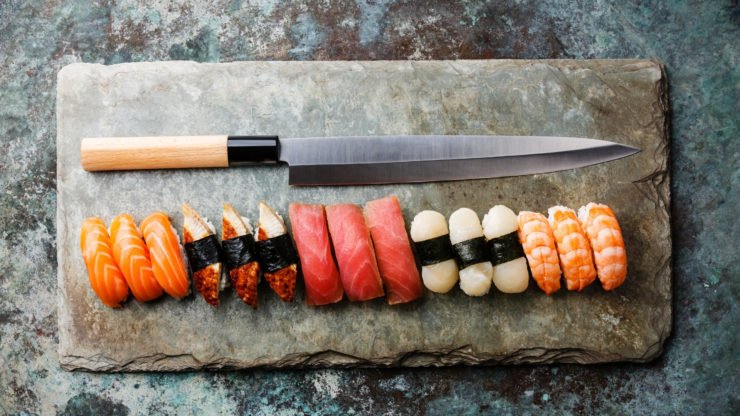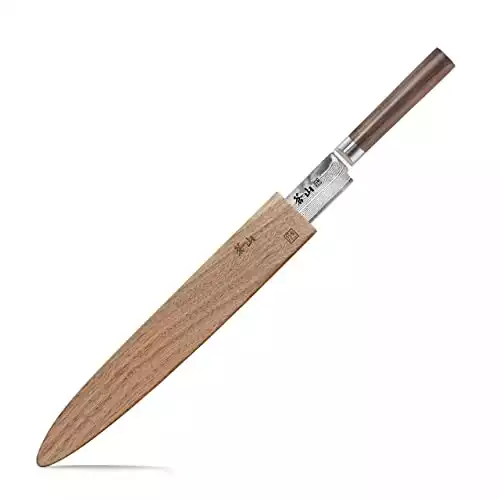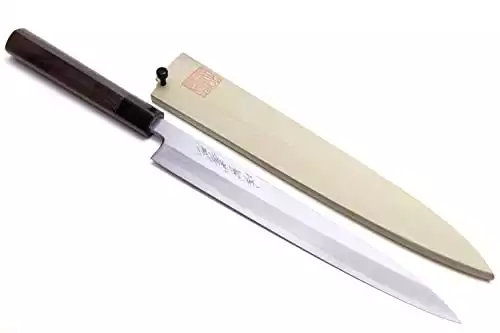At its most basic, sushi is a deceptively simple thing. It is made, after all, of little more than steamed rice, fresh fish, and sometimes a special Japanese seaweed. But before a perfectly plated tuna sashimi or California roll hits your plate, it requires extreme attention to detail at every step — especially while cutting the thin slices of fish that sushi is known for.
That’s why mastering sushi is one of the biggest projects that any home chef can undertake. I was lucky enough to have a direct mentor while learning to make sushi in a Portland, Oregon restaurant, and I’d like to pass on some of that experience to you.
Today, I’ll explore some of the fundamentals you should keep in mind when finding the best sushi knife to learn with or use at home. There are actually a few types of knives you should consider if you want to make your sushi experiment a successful one.
In This Article
Before We Begin: What Is A Sushi Knife, Anyway?
Just like Western kitchens, professional Japanese kitchens use a wide variety of knives, each with their own special purpose.
But in a Japanese kitchen, there isn’t any one knife that’s known just as a “sushi knife”. In fact, even a dedicated sushi restaurant still uses a full selection of knives in all of their meal preparations.
So when you’re looking for the best sushi knife for your kitchen, you’ll first need to narrow down your choices. To start, you should specifically look at the yanagiba. It’s a specialized Japanese form of slicer knife with a steep blade angle.
The yanagiba is the main knife style we’ll be covering in the following three knife reviews. But if you’re interested in collecting a full selection of knives for making sushi and sashimi, be sure to check out the “Runners Up” section that follows for a full breakdown.
And now, onto the best sushi knives for your home kitchen!
Best Overall: Cangshan J Series 12 Inch Sashimi Knife
It’s not often that you’ll find a newcomer to the Japanese knife market that’s making top-quality blades. But that’s exactly what Cangshan is doing — and they have an award from the prestigious Red Dot Design Series to prove it.
The J Series Sashimi is a blend of Western and Eastern knife styles that are offered at a fair price. In my view, this is an ideal sushi knife for at-home use. I’ll explain.
The blade on Cangshan’s J Series Sashimi Knife falls right between the hardness of German knives and traditional Japanese ones. At 60 Rockwell hardness, it’s sharp enough to make paper-thin slices of fish. But thanks to German tempering and steel-blending methods, it’s both stain-resistant and chip-resistant.
That’s combined with a substantial 12-inch blade length, giving this sashimi knife plenty of cutting power. It’s nicely balanced by a durable African blackwood handle, giving the knife an easy cutting motion.
Pair all of that with a natural wood saya (sheath) for protection and a lifetime warranty against manufacturer defects, and you have one heck of a sushi knife. It’s a truly impressive piece of equipment that’s offered at a surprisingly low price for its quality.
What we like
- High carbon stainless steel blade is sharp, durable, and low maintenance
- Natural hardwood handle gives the knife great balance
- Very affordable given the quality of its construction
What We don’t
- Still fairly pricey for many home chefs’ budgets
- Will not be as sharp as harder, more traditional Japanese blades
- Comes sharpened on both sides of the blade (not traditional single-side sharpening)
Best Value: Mercer Culinary Asian Collection 12 Inch Yanagi
A top-quality, traditionally made sushi or sashimi knife is outside of the budget of most at-home chefs. It certainly is for me, as a truly traditional sushi knife can cost well over $300!
If you’re looking for a more affordable starter knife that will let you get a feel for making sushi at home, Mercer Culinary’s Yanagi is the way to go. It has a lot to offer at a shockingly low price.
First of all, the blade is long enough to allow for the long, sweeping cuts required for fresh sushi. That’s complemented by a traditional single-edge sharpening, giving this knife a much sharper edge than you’d expect.
This knife has a stain-resistant, high carbon steel formulation for the blade. In short: It’s high quality and low maintenance, making it an excellent knife for anyone learning to make sushi.
That’s all in addition to a natural hardwood handle, for better balance and a pleasant aesthetic. At this price, amd with a limited lifetime warranty included, you won’t find any better sushi knife.
What we like
- Most affordable yanagi on the market today
- High carbon stainless steel blade is durable and low maintenance
- Excellent knife for sushi first-timers
What We don’t
- Lacks some of the fine details of more expensive sushi and sashimi knives
- Handle gets slightly slippery when wet
- Not as sharp as
Best Upgrade: Yoshihiro Shiroko High Carbon Steel Kasumi Yanagi
As you reach the $300 range, you’ll start finding sushi knives that are high quality enough to use in a professional setting. This may be overkill for most home chefs, but if you’re looking for the best of the best this is where you should start.
Yoshihiro’s Shiroko High Carbon Steel Yanagi represents the best of traditional sushi knife craftsmanship.
The major difference you’ll notice between Yoshihiro’s high-dollar sashimi knife and more affordable models is its sharpness. This is the result of the quality of the steel used, and a time-consuming sharpening method that lets it slice through fish with incredible ease.
Made from steel known as “White Steel #2”, Yoshihiro’s yanagi comes in at a remarkable 62-63 Rockwell hardness. This makes it sharper than any other knife featured in this review — but also more brittle.
This is not a sashimi knife for beginners, as it requires special care and maintenance. This includes keeping the blade oiled, and thoroughly drying it in-between cuts. It can be a lot of work, especially if you’re just getting started.
The extra-sharp steel blade is given another advantage through the use of an urasuki grind. This complements a traditional single-edge sharpening with a hollow curve on the back of the knife. As a result, it slices through fish with minimal friction, making for incredibly clean and precise cuts.
Overall, Yoshihiro’s yanagi is a fantastic knife for someone who’s already familiar with using sushi and sashimi knives. It’s far from being a beginner’s knife, but experienced chefs will love its unerring sharpness.
What we like
- Sharpest sushi knife in this review
- Urasuki grind makes each cut almost frictionless
What We don’t
- Carbon steel blade requires extra care and maintenance
- Quite expensive for home use
- Not great for beginners
Runners Up: Other Useful Sushi Knives
Now that we’ve covered the best yanagiba sushi knives, I’d like to take a moment to look at the “supporting cast” of knives that will round out your Japanese kitchen. These are the knives you’ll use to prepare vegetables for sushi rolls, garnishes for sashimi plates, and to cut the rolls themselves.
Gyuto
The gyuto is the Japanese kitchen’s equivalent of the chef’s knife.
The gyuto is an indispensable tool for preparing almost any ingredient and can be used to slice sushi rolls into individual servings.
Shun’s 8 inch Gyuto is a classic example of this knife style.
Usuba, Nakiri, and Mukimono
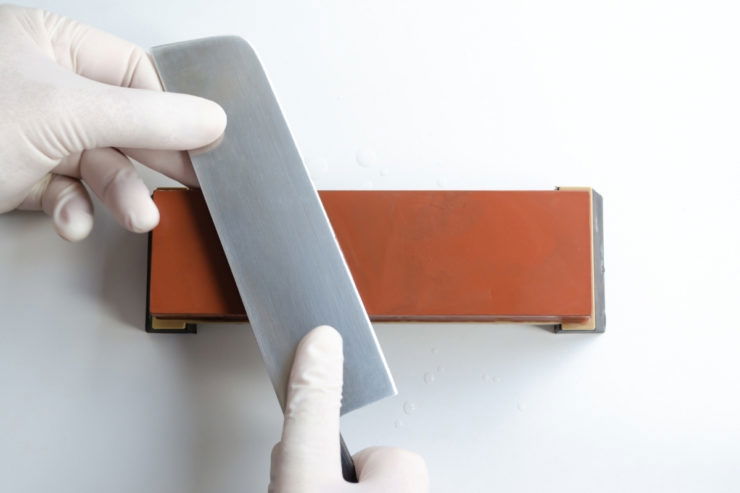
These knives represent three variations on a single theme: The Japanese vegetable knife.
Each features a blade that’s shorter in length, but taller in height than a sushi knife. And any of the three are excellent for preparing the vegetables that will go into your sushi rolls, or garnishes for your sashimi plates.
Yoshihiro’s Hammered Damascus Usuba represents the best of all three styles.
Deba
The deba is the Japanese kitchen’s equivalent of a cleaver.
This knife is intended only for use with fish and poultry. Its tall and heavy blade makes easy work when breaking down whole fish. After that, you can slice the resulting fillets into sushi or sashimi.
Dalstrong’s 6 Inch Deba is a modern take on the style that’s offered at a fair price.
Santoku
The knife of “three virtues”, the santoku has made its way into many American kitchens thanks to its versatility.
While it won’t make sushi-thin cuts of fish, a santoku knife can handle most other cutting tasks.
Shun’s 7 Inch Santoku is one of the most popular Japanese knives in the American market.
Buyer’s Guide: How to Choose the Best Sushi Knife
What makes a good sushi knife? It’s a refined combination of blade length, edge angle, and sharpness that separates the best sushi knives from mediocre ones.
You’ll also want to be aware of the cost, care, and maintenance that come with traditional Japanese knives. With that in mind, let’s take a deeper dive into the qualities that make for top-notch sushi knives.
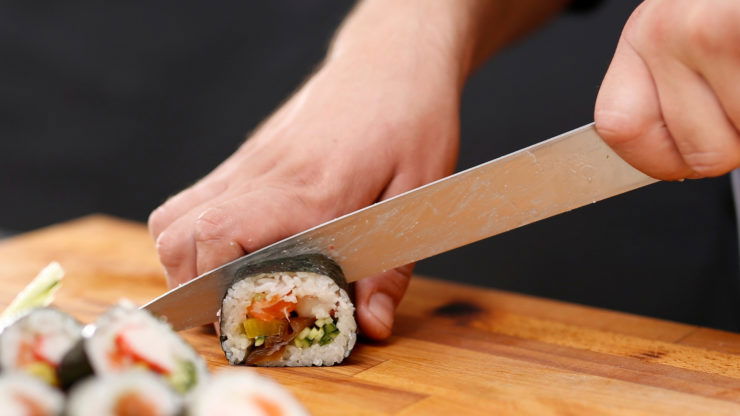
Blade
A sushi knife’s blade needs to get three things just right:
- The material it’s made of. The blade has to be extremely sharp to achieve the thin, precise cuts of fish required for sushi. The harder the steel the knife is made of, the sharper an edge it can take. The best sushi and sashimi knives have a Rockwell hardness rating of at least 60, though more is better.
- The angle of its edge. A traditional Japanese sushi knife will have a single bevel for its edge. That means it’s only sharpened on one side, unlike a chef’s knife. This steeper angle means you’ll have to cut with a pulling motion — but it also makes a cleaner, smoother cut.
- The length of the blade. Because you’ll be making long, pulling cuts with a sushi knife, it has to have a longer blade than a chef knife. Ten inches is a good starting point, though 12 inches is the real sweet spot.
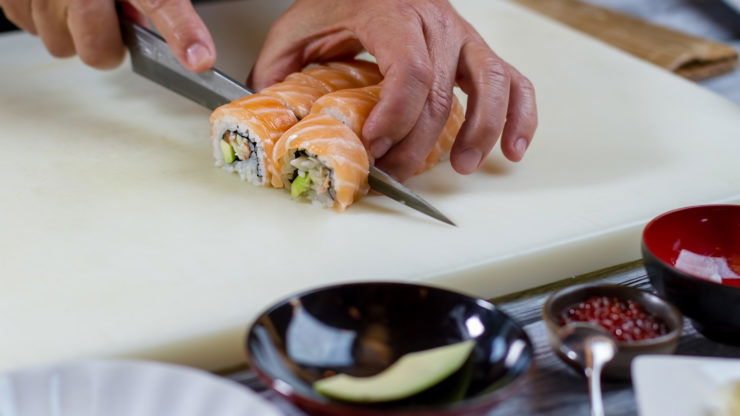
Construction
You should only ever buy a sushi knife that has a full tang construction. This means that the steel of the blade extends all the way through the knife, from the tip of the blade to the back of the handle. It ensures that the knife is as durable as possible, and worth investing your kitchen budget in.
Additionally, every yanagiba worth its cost will have a natural wood handle. This isn’t just an aesthetic choice: The weight of hardwood helps to balance the longer blade, making for a knife that’s easier to make smooth cuts with.
Care & Maintenance
Traditional sushi knives have a well-deserved reputation as being high maintenance.
If you buy a knife with an untreated carbon steel blade, you will need to be extra careful with it. This includes keeping it oiled, drying it on a fresh towel between cuts, and handling it gently to prevent chipping.
If you opt for a more modern high carbon stainless steel blade, though, there’s significantly less maintenance. Keeping your blade dry between uses and storing it safely will be enough to keep it in great shape.
For either material, you’ll need to keep the edge razor sharp to do its job well. Enthusiastic home cooks may want to learn how to sharpen their own knives, to keep the finest edge possible at all times.
Otherwise, you can take your sushi knife to a professional sharpener about every three months. This is more frequent than you’d expect to sharpen other knives — because a sushi knife has to be incredibly sharp to do its job well.
What You Can Expect to Pay For A Great Sushi Knife
There are two answers to the question of “how much should I pay for a sushi knife?”:
- For home use
- For commercial/professional use
Home-use sushi knives will see a lot less action than those used in a commercial setting. To get the best quality possible, you can expect to pay $150 or more. But for home chefs that aren’t as obsessive over the details of their sushi, an inexpensive knife is an acceptable substitute.
With commercial or professional-grade sushi knives, the sky’s the limit for their price. $200 is about the least you’ll find a pro-quality sushi knife for, while highly regarded brands can retail for $1000 or more.
Frequently Asked Questions About Sushi Knives
As we’re closing in on the end of this guide, let’s take a moment to look at some of the most common questions about sushi knives. Add this to what you’ve already learned in the sections above, and you’ll have a full picture of how to choose the best sushi knife for your home kitchen.
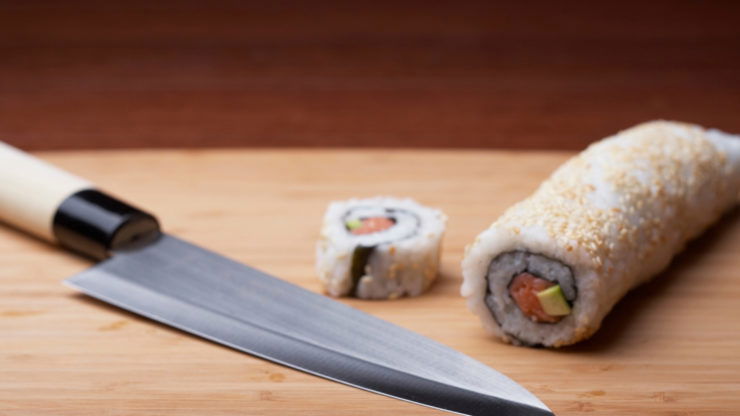
Are there any limitations to using a high carbon blade?
When you get into the world of Japanese knives, you’ll find many fans of high carbon steel blades. And indeed, the additional carbon in Japanese steel can make for harder — and sharper — knives.
Because of this, carbon steel was the metal of choice for top-quality blades for decades. Even so, traditional carbon steel blades require a lot more care and maintenance than more modern stainless steel blades. This includes keeping them dry (even in-between cuts), oiling them frequently, and handling them gently so their blades don’t get chipped.
Thanks to advances in metallurgy, though, you can have your carbon steel cake and eat it too. Newer generation Japanese knives are often made with high carbon stainless steel, offering the best advantages of both types of metal. They’re sharp, durable, and low maintenance — what more could you ask for?
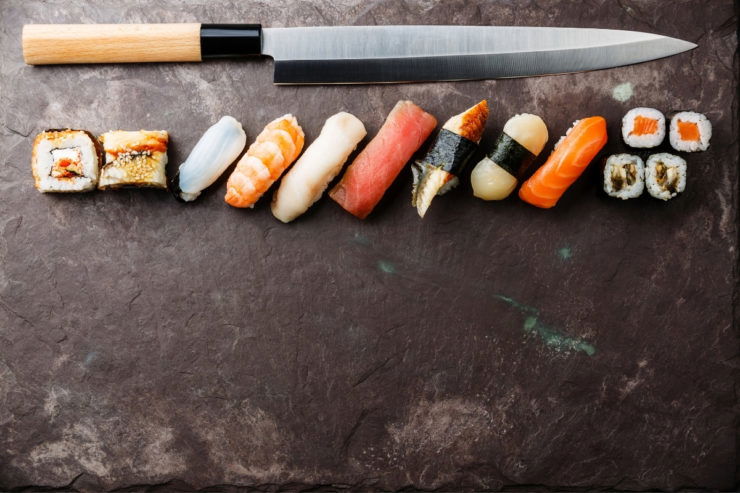
What makes a good sushi vs sashimi knife?
The same yanagiba knives featured in these reviews work equally well for sushi and sashimi.
Why is that? Because the only role of a traditional sushi knife is to thinly slice fish. Sushi includes fish served over seasoned rice, while sashimi consists of sliced fish served without rice.
If you’re thinking of slicing sushi rolls, though, the sushi kiri knife is made for that job. Its curved blade makes it easy to cut through rolls without compressing them. Though in my experience, a razor sharp gyuto can get that job done just as well.
Are there sushi knives built for left-handed chefs?
There absolutely are sushi knives for left-handed chefs. In fact, just about every Japanese knife style can be found in a left-handed version. Because they’re specially made, though, expect to pay more than you would for a standard right-handed version.
My Recommendations
And with that, we’ve come to the end of our discussion on finding the best sushi knife. Which of the featured knives do you think deserves a place in your kitchen? To recap:
The Cangshan J Series 12 Inch Sashimi Knife blends the best of home and professional use qualities, at a cost right in the middle of the two. It’s beginner-friendly stainless blade makes it excellent for home chefs who are learning to make sushi.
Mercer Culinary’s Asian Collection 12 Inch Yanagi is the only sushi knife you’re going to find for under $100 that you actually want to use. It’s my top recommendation for sushi first-timers, as it will let you get a feel for how to use these long single-edged knives.
Experienced home chefs may want to invest more in the Yoshihiro Shiroko High Carbon Steel Kasumi Yanagi, a fantastic example of a traditional Japanese yanagiba. It’s the sharpest knife of the bunch. If you care for it well, this knife will make picture-perfect sushi for decades to come.
